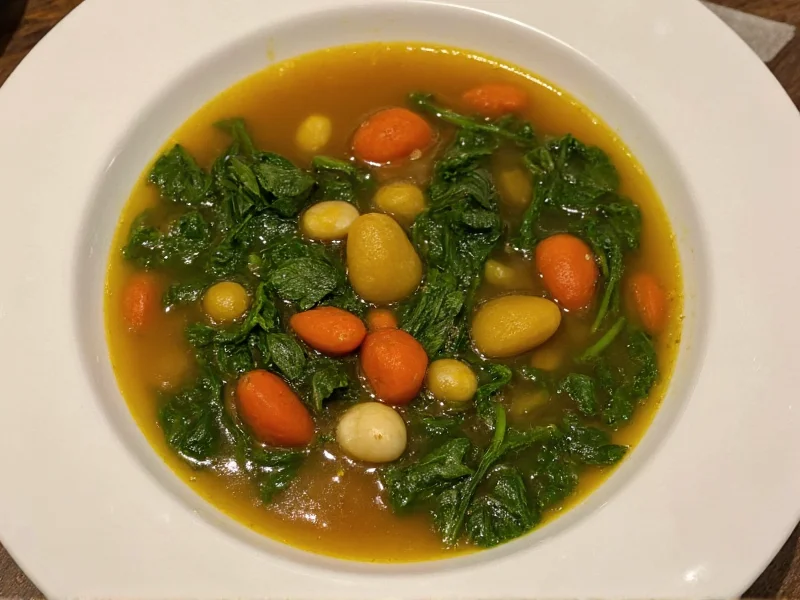Swiss chard soup stands out as one of the most nutritionally rewarding vegetable-based soups you can prepare. Unlike many seasonal greens, Swiss chard remains available year-round and adapts beautifully to various culinary approaches. This leafy vegetable belongs to the same family as beets and spinach but offers a unique flavor profile that works exceptionally well in soups.
Why Swiss Chard Soup Deserves a Place in Your Recipe Collection
Among leafy green soups, Swiss chard soup offers distinctive advantages. The vegetable's thick, crunchy stems provide texture while the tender leaves wilt perfectly into broth. Compared to spinach soup, Swiss chard maintains its structure better during cooking, preventing that sometimes-mushy texture. Kale soup enthusiasts will appreciate how Swiss chard offers similar nutritional benefits with a more delicate, less bitter flavor profile.
Understanding Swiss Chard Varieties and Selection
When preparing authentic Swiss chard soup, recognizing the different varieties matters. You'll commonly find:
| Variety | Flavor Profile | Best For Soup? |
|---|---|---|
| Rainbow Swiss Chard | Mild, slightly earthy | Excellent - colorful stems add visual appeal |
| Rhubarb Chard | Slightly more bitter | Good - works well with robust flavors |
| Fordhook Giant | Sweetest variety | Best - ideal for delicate soups |
Select bunches with crisp, vibrant leaves and firm, unblemished stems. Avoid any with yellowing leaves or limp stalks, as these indicate age and will result in less flavorful soup. The fresher the Swiss chard, the better your easy Swiss chard soup recipe will turn out.
Essential Ingredients for Perfect Swiss Chard Soup
Creating a balanced swiss chard soup with white beans requires attention to ingredient quality:
- Swiss chard - 2 large bunches (separate stems from leaves)
- Aromatic base - 1 onion, 2 carrots, 2 celery stalks, 3 garlic cloves
- Protein component - 1 can white beans (cannellini or navy) or diced chicken
- Liquid - 6 cups quality broth (vegetable or chicken)
- Flavor enhancers - 2 tbsp olive oil, 1 tsp dried thyme, salt and pepper to taste
- Finishing touches - lemon juice or zest, red pepper flakes
The best way to clean swiss chard for soup involves submerging the leaves in cold water to remove any grit, then slicing stems separately from leaves since they require different cooking times. This technique prevents overcooking the delicate leaves while ensuring the thicker stems become tender.
Step-by-Step Swiss Chard Soup Preparation
Follow these professional cooking techniques for restaurant-quality results:
- Prepare the Swiss chard: Chop stems into 1/2-inch pieces and leaves into 1-inch squares
- Sauté aromatics: Heat olive oil over medium heat, add onions, carrots, and celery until softened (5-7 minutes)
- Add garlic and Swiss chard stems: Cook for 3 minutes until slightly tender
- Pour in broth and bring to gentle boil
- Add white beans and thyme, reduce heat and simmer for 15 minutes
- Stir in Swiss chard leaves and cook until wilted (3-5 minutes)
- Season with salt, pepper, and a squeeze of fresh lemon juice
This healthy swiss chard soup for winter comes together in just 25 minutes from start to finish. For a creamy swiss chard soup recipe variation, blend half the soup before adding the greens, or stir in 1/4 cup of coconut milk at the end.
Expert Cooking Tips for Superior Results
Professional chefs recommend these techniques when making how to cook swiss chard soup:
- Cook stems first: The stalks need more time than leaves, so add them to the pot 5-7 minutes before the greens
- Acid balance: A splash of lemon juice or vinegar at the end brightens flavors and enhances nutrient absorption
- Layering flavors: Sauté a Parmesan rind with the aromatics for umami depth (remove before serving)
- Texture control: For heartier soup, chop ingredients larger; for smoother texture, dice smaller
- Don't overcook: Swiss chard leaves should remain vibrant green, not dull and olive-colored
Delicious Variations to Explore
Once you master the basic vegetarian swiss chard soup, experiment with these adaptations:
- Mediterranean style: Add diced tomatoes, olives, and oregano
- Protein boost: Include cooked chicken, turkey sausage, or chickpeas
- Creamy version: Blend with potatoes or cauliflower for richness without dairy
- Spicy kick: Add harissa paste or red pepper flakes during cooking
- Grain addition: Stir in cooked farro, barley, or quinoa for heartier meal
Serving Suggestions and Storage Instructions
For optimal enjoyment of your swiss chard soup preparation:
- Serve immediately while hot, garnished with fresh herbs and lemon zest
- Pair with crusty bread or a simple green salad for complete meal
- Store leftovers in airtight container in refrigerator for up to 4 days
- Freeze portions for up to 3 months - note that texture may change slightly upon thawing
- Reheat gently on stove, adding small amounts of broth if soup has thickened
The swiss chard soup storage instructions are straightforward since the ingredients hold up well. The soup often tastes even better the next day as flavors continue to meld. When reheating, add a splash of broth or water to restore the ideal consistency.
Nutritional Powerhouse: Health Benefits Explained
Swiss chard soup delivers impressive nutritional benefits that make it worthy of regular rotation in your meal plan. One serving provides:
- Over 300% of your daily vitamin K needs - crucial for blood clotting and bone health
- Nearly 100% of vitamin A - essential for vision and immune function
- Significant vitamin C - supports immune system and collagen production
- Excellent magnesium source - regulates muscle and nerve function
- High potassium content - helps maintain healthy blood pressure
- Dietary fiber from both the greens and added beans
The nutritional benefits of swiss chard soup extend beyond basic vitamins and minerals. The combination of leafy greens, vegetables, and broth creates a low-calorie, high-nutrient meal that supports overall wellness. Regular consumption may help reduce inflammation and support cardiovascular health.











 浙公网安备
33010002000092号
浙公网安备
33010002000092号 浙B2-20120091-4
浙B2-20120091-4